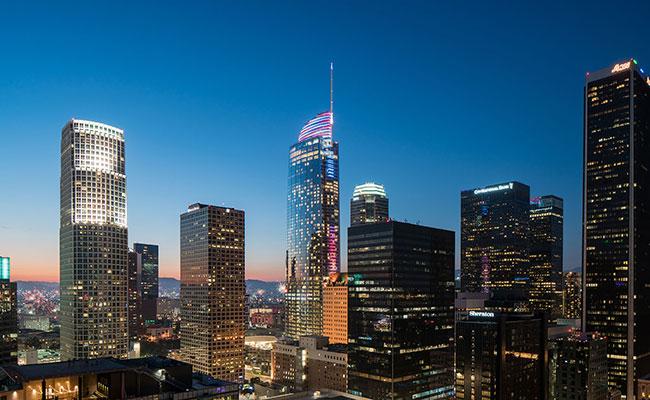Sustainable Design: Optimizing Energy Use in Los Angeles From the Outside In
Emphasizing smarter lifecycle designs to ensure our clients’ projects will thrive and endure

Increased climate variability and surging population growth are placing greater demands on limited resources such as water, energy, and physical space. Our teams are considering how buildings and infrastructure can be designed to more effectively cope with these stresses and perform well into the future. Facilities need to be built not only to operate in greater harmony with nature but also to withstand the forces it may unleash.
Tetra Tech understands the value of resiliency planning and sustainable design in addressing emerging risks associated with a changing world. We develop unique solutions to some of the toughest problems—using both cutting-edge technologies and commonsense approaches.
As conceptual frameworks, resilience and sustainability increasingly guide decisions in the planning, design, and engineering of our projects. Resiliency emphasizes robustness and the ability to recover, while sustainability considers measures of environmental impact and resource conservation. Both concepts share common end goals in contributing to society’s capacity to thrive in a meaningful way. In this Sustainable Design article series, we highlight Tetra Tech projects that represent some of the industry’s very best examples of resiliency planning and sustainable design.
Sustainable Design
Where resilience asks how to build infrastructure that can withstand a changing environment, sustainability considers how facilities can be designed to integrate with their surroundings—minimizing environmental impacts, waste generation, and energy consumption. Tetra Tech’s growing global sustainable infrastructure practice is using innovative design approaches to control temperature, reduce energy costs, and conserve water.
Optimizing energy use in Los Angeles from the outside in
The design elements—and the strategic use of those elements—that go into creating a building facade play a critical role in energy performance. With the Wilshire Grand, a 73-story hotel and office tower in downtown Los Angeles, California, and the tallest building in the western United States, an envelope study performed during the conceptual stage informed an ideal facade design that balances energy efficiency and aesthetics to help meet the project’s aggressive sustainability goals.
Glumac, A Tetra Tech Company, conducted an envelope analysis that addressed a multifaceted design challenge: Create a high-performing envelope—the physical barrier between interior and exterior environments—that integrates the owner’s priority of a design fitting with Class A office space and a 5-star hotel. Tetra Tech’s Los Angeles and New York City offices collaborated to develop design concepts. Our team analyzed numerous envelope alternatives and carefully considered how climatic factors and specific site conditions would influence performance. Data and insights gained through energy modeling enabled the project team to fine-tune the envelope parameters—determining the best use of window glazing, vision glass, insulation, and shading devices—to optimize both the elegance and the energy efficiency of the facade. Drawing on their significant high-rise expertise, our New York City office also provided peer reviews throughout design and construction.
“We developed energy models and assessed the possible impacts of different window and wall configurations on the building’s facade with different orientations,” said Michael Adams, LEED AP, BD+C, energy analyst with Tetra Tech. “Since Southern California is a cooling-driven environment, we focused on the efficiency of the south- and west-facing sides of the building where our cooling load is the highest—especially during the late afternoon when sun penetration is most direct.”
In engineering a final design, our team worked closely with the owner to maximize the provision of windows without sacrificing energy performance. “This required balancing the owner’s expectations with the project’s energy goals as well as the California energy code, which is one of the strictest in the country,” said Kameron Beeks, LEED AP BD+C, a Los Angeles-based mechanical engineer with Tetra Tech.
Tetra Tech also worked with the project structural engineers, as the structural framing for the Wilshire Grand required large columns on the perimeter of the building. “We collaborated with their team to set up a grid that enabled the columns to be placed in locations acceptable to the hotel and office tenants, but which still benefited the facade in terms of energy savings and creating optimal window sizes,” Kameron said.
Combined with other energy-efficiency measures, the Wilshire Grand’s high-performance facade design is anticipated to help save $896,428 annually on energy costs—a 24.2 percent overall energy cost reduction—relative to an ASHRAE 90.1 2007 baseline, the minimum requirement for energy-efficient building design.
A commitment to our future
A city is the sum of its parts—buildings, communities, coastlines—and efforts to enhance long-term resilience and sustainability must reach across all of them. Tetra Tech’s community resiliency specialists and global sustainable infrastructure teams are demonstrating what can be achieved through collaboration, creativity, and an unwavering dedication to the highest principles in planning, design, and engineering. By leading in projects that advance resiliency and sustainability, we can continue to deliver the most effective solutions to our clients and help ensure a vibrant and enduring future.

